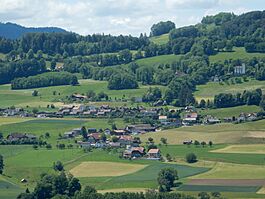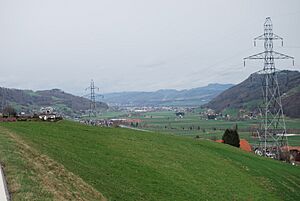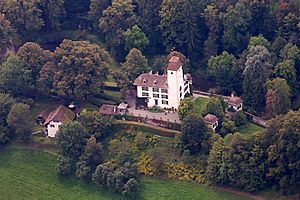Rümligen facts for kids
Quick facts for kids
Rümligen
|
||
|---|---|---|

Rümligen Castle in Rümligen
|
||
|
||
| Country | Switzerland | |
| Canton | Bern | |
| District | Bern-Mittelland | |
| Area | ||
| • Total | 4.7 km2 (1.8 sq mi) | |
| Elevation | 606 m (1,988 ft) | |
| Population
(Dec 2019)
|
||
| • Total | 466 | |
| • Density | 99.1/km2 (256.8/sq mi) | |
| Postal code |
3128
|
|
| Surrounded by | Gelterfingen, Kaufdorf, Kirchenthurnen, Riggisberg, Rüeggisberg | |
Rümligen was a small town, also called a municipality, in Switzerland. It was located in the Bern-Mittelland area, which is part of the canton of Bern. On January 1, 2021, Rümligen joined with the nearby town of Riggisberg.
Contents
History of Rümligen
Rümligen was first mentioned in old records in 1075. Back then, it was called Rumelingen.
The oldest sign of people living here is a hidden collection of Bronze Age axes. This shows that people lived in the area a very long time ago.
The Lords of Rümligen
During the High Middle Ages, powerful noble families called the Freiherr von Rümligen owned a lot of land. Their land stretched between the Gürbe and Sense rivers. They gave some of their land to help build and support Rüeggisberg and Röthenbach Priories (types of monasteries).
In 1380, the Sommerau-Rümligen family took over the land. This happened when Alisa von Rümligen married into the Sommerau family. By 1388, the Freiherren came under the control of the city of Bern. However, they still owned the land for another 150 years.
In 1515, the Sommerau-Rümligen family lost their power over the area. By the 1600s, several rich families from Bern owned Rümligen. In 1709, a man named Samuel Frisching built the Rümligen Castle we see today. He built it around the old medieval castle.
Village Life and Work
Rümligen has always been part of the larger church area of Thurnen. For a long time, farmers in the village grew crops in the valley. They also raised cattle in the mountains during different seasons. Even today, many jobs (about 43%) in Rümligen are still in farming. About two-thirds of the people who work here travel to jobs in bigger cities nearby. The local community also runs a small school in the village.
Geography of Rümligen
Rümligen covered an area of about 4.7 square kilometers (1.8 square miles). Most of this land, about 75.5%, was used for farming. Forests covered about 16.6% of the area. Buildings and roads made up about 7.5% of the land. A very small part, 0.4%, was rivers or lakes.
The former town is located in the Gürbe Valley, close to the Längenberg mountain. It includes the main village of Rümligen. It also has smaller groups of houses called hamlets, like Hermiswil and Hasli. There are also many farmhouses spread out across the area.
On January 1, 2010, Rümligen became part of the new Bern-Mittelland administrative district.
Rümligen's Coat of Arms
The design on Rümligen's coat of arms is simple and striking. It is divided into two parts: a silver (white) top and a red bottom. On this background, there are two stars. The star in the silver part is red, and the star in the red part is silver. This means the colors of the stars are opposite to the background they are on.
Population and People
In 2019, Rümligen had a population of 437 people. A small number of these residents, about 5.3%, were foreign nationals.
Most people in Rümligen speak German. In 2000, about 96.7% of the population spoke German as their main language. A few people also spoke French or Italian.
In 2008, the population was almost evenly split between males and females. About 51.7% were male and 48.3% were female. Most of the people living in Rümligen were Swiss citizens.
Age Groups
In 2012, children and teenagers (ages 0–19) made up 18.0% of the population. Adults (ages 20–64) were the largest group, at 65.8%. Seniors (over 64 years old) made up 16.2% of the population.
Marital Status and Homes
In 2000, about 28.6% of the people in Rümligen had never been married. About 47.1% of the homes in the town were single-family houses in 2011.
The chart below shows how the population of Rümligen has changed over time:

Important Heritage Site
Rümligen Castle is a very important historical site. It is listed as a Swiss heritage site of national significance. This means it is protected because of its historical and cultural value.
Economy and Jobs
In 2011, Rümligen had a low unemployment rate of 1.14%. This means most people who wanted to work had jobs. There were 124 people working in the town.
Types of Jobs
- Farming: 62 people worked in farming. There were about 20 businesses in this area.
- Manufacturing and Construction: 27 people worked in these areas. There were 8 businesses.
- Services: 35 people worked in the service industry. This included things like shops, restaurants, and professional services. There were 15 businesses in this sector.
Many people who lived in Rümligen traveled to other towns for work. In 2000, 145 people left Rümligen to work elsewhere. Only 44 people came into Rümligen for work. This shows that more people left the town for jobs than came in. About 54.8% of workers used a private car to get to work.
Religion in Rümligen
Based on a 2000 survey, most people in Rümligen were part of the Swiss Reformed Church. About 77.0% belonged to this church. A smaller group, about 6.3%, were Roman Catholic. Some people belonged to other Christian churches. About 7.59% of the population did not belong to any church.
Education in Rümligen
In Rümligen, about 63.5% of adults have finished high school (called upper secondary education). About 15.2% have gone on to higher education, like university.
School System
The school system in the Canton of Bern starts with one year of optional Kindergarten. After that, students go to six years of Primary school. Then, they attend three years of lower Secondary school. In secondary school, students are grouped based on their skills. After secondary school, students can continue their education or start an apprenticeship (learning a trade on the job).
During the 2011-2012 school year, 15 students attended primary school in Rümligen. There were no kindergarten classes in the town. All 15 primary students were in one class.
In 2000, 40 students lived and went to school in Rümligen. However, 33 students from Rümligen went to schools outside the town.
See also
 In Spanish: Rümligen para niños
In Spanish: Rümligen para niños








